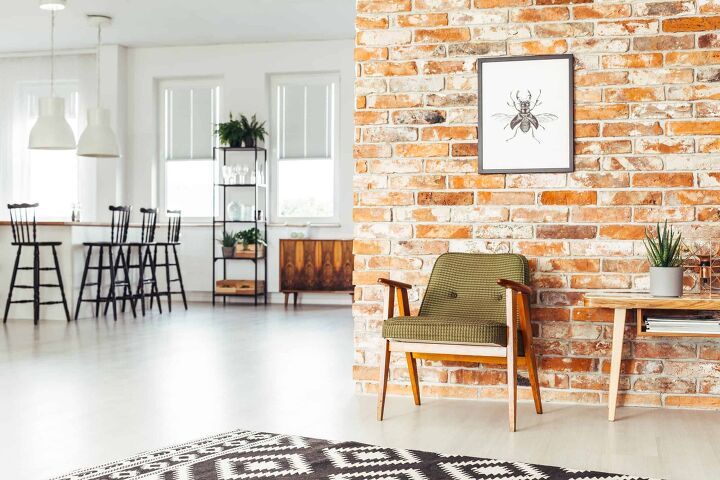How Do I Fix A Brick Wall That Has Shifted?

A brick wall is usually known for its structural integrity. If you’ve noticed one of your brick walls has shifted, this can be a cause for concern. It is vital to fix the brick wall as soon as possible. Except, how exactly do you do that?
To fix a brick wall that has shifted, you will need to figure out why it has moved. There could be cracking, efflorescence, or spalling. Your brick wall could be bowing, or the mortar may be deteriorating. Once you identify the problem, there are several steps you can follow to reconfigure the sturdiness of the brick wall.
This article will explain all the possible reasons that your brick wall could have shifted. Also, we’ve provided solutions to these problems so that you can fix the issue and get your wall back in good shape.
Need Brick or Stone Flatwork Repair?
Get free, zero-commitment quotes from pro contractors near you.

Possible Problems With Your Brick Wall
Before you try to fix your brick wall, it is essential to diagnose the problem first. Several things may be causing your brick wall to shift.
Cracks can appear in your brick wall and indicate several things:
- Vertical cracking inside building corners is a result of thermal expansion at the edge. When this happens, it means expansion joints were not installed during original construction.
- Vertical cracking on outside building corners is a result of structural movement. If the building is older, a steel column was likely built into the corner.
Over the years, water can seep through the brick and collect on the steel, causing it to rust. The rust pushes the brick away from the building and causes cracks.
- Vertical cracking can develop above a window head due to an undersized lintel.
- Diagonal cracking can occur in the middle of the brick wall and at windows and doors. These cracks are a result of the building foundation settling unevenly.
Causes For Brick Wall Problems
Efflorescence may be causing your brick wall problems. Efflorescence is the formation of salt on the surface of your brick wall resulting from water evaporation. If this is the case, it does not necessarily pose a structural problem.
You can scrub the salt off with water. However, efflorescence may indicate that your brick wall has poor drainage. Efflorescence means that moisture is trapped inside the wall and cannot drain properly.
Your brick wall can also experience something called spalling. Spalling occurs when pieces of brick flake off of your wall. Occasionally, substantial portions of the brick can flake off and spell problems for you.
Spalling may occur because of structural movement that exerts excess pressure on the bricks. Spalling may also be a result of soft brick materials absorbing moisture and freezing.
Finally, spalling can occur due to moisture getting trapped behind bricks, freezing, and expanding.
Additional Reasons Your Brick Wall May Have Shifted
Another problem you might encounter is a bowing brick wall. Bowing is most likely a result of your bricks expanding due to moisture absorption. If your brick wall is bowing, it probably doesn’t have the proper expansion joints. If not attended to promptly, entire bricks can dislodge.
Your brick wall may have problems because its mortar joints are deteriorating. Mortar joints are weaker than bricks themselves and will deteriorate over time.
How To Repair A Brick Wall
Once you know what is causing your brick wall problems, you can fix it! However, it is easier to repair a veneer wall than a solid brick wall. Consult a professional for problems with load-bearing walls.
If the wall has a few simple cracks in it, you can fill these in with mortar. If you’re dealing with vertical cracks, this poses a bit more of a problem. You will need to remove the bricks around the crack and replace them.
Are the cracks in the wall horizontal? If so, use a cavity wall tie to tie the internal and external walls together. However,f the cracks in the wall are more complicated; you can drill into them. Inject thixotropic resin grout into the holes and then add mortar once it has dried.
Are Your Bricks Shifting Inward?
If the brick wall is shifting because the mortar between the bricks has disappeared, you can fix it by tuckpointing. Tuckpointing is a process of cleaning and replacing mortar lost from the joints. This process will help to stabilize the wall and keep water from entering the brick wall.
However, if bricks are shifting in a veneer wall, you can add fasteners to the mortar joints. These fasteners connect to the building behind the brick wall. Because a veneer wall doesn’t provide structural support, it can easily be taken apart and rebricked if the shifting is too intense. For severe bowing, you might need to rebrick the entire brick wall. You should consult a professional for more severe issues like this.
How To Replace A Brick
If there is damage to your veneer brick wall, replacing a few bricks is easy for you to take on. However, if there is damage to a structural wall, you should consult a professional.
To replace a damaged brick on your veneer wall, you will need the following tools:
- A matching brick
- A cold chisel
- A hammer
- A wire brush
- A pointing trowel
- A joint strike tool
- Mortar mix
- Eye protection and leather work gloves. Safety first!
Step 1: Choose Your Brick
Pick a brick that matches the style of your current veneer wall. There are many different styles and sizes, so be sure to pay special attention to the one you choose! Usually, it’s a good idea just to choose the same type of brick that your wall is made out of so that it doesn’t look weird or ‘off.’
Step 2: Remove The Damaged Brick
Remove the damaged brick. Break the brick apart using the chisel and hammer. If you have a power drill and a masonry cutting wheel, you can use these in place of the chisel and hammer.
These tools will speed up the process but are not necessary. When removing the damaged brick, be careful not to damage the bricks around it.
NOTE: If you are removing multiple bricks, start at the top and work your way down.
Step 3: Clean The Debris
Clean out any debris from the brick hole. Remove mortar, dirt, and dust with the wire brush and vacuum. Rinse out the hole with water. After you’re finished cleaning out the debris and rinsing the area, you should dab the area dry and wait for it to be most of the way dry before you apply any mortar and install the new brick.
Water helps the mortar set quicker. So if the surface is wet, the mortar may set too quickly depending on the type that you have. It’s better to apply it to a dry area.
Step 4: Apply Mortar
Mix the mortar and use the pointing trowel to layer the mortar onto the bottom and sides of the brick opening. The mortar should be about 1 inch thick. At this point, you want to prepare to add the new brick to the opening. Dampen it slightly and apply mortar to the top and sides of the brick.
Step 5: Install The New Brick
Add the new brick into the opening. Tap it into place with the pointing trowel, and scrape away any mortar that oozed from around the brick. Make sure you remove the excess mortar now before you move on; otherwise, it will be harder to remove later on.
Step 6: Mist The Brick
Spray the brick with water to make sure the mortar sets. The brick should not be soaked, though. Spray it until it changes color, but the brick should not be dripping wet.
Related Questions
What are the different types of brick walls?
There are three types of brick walls: veneer, solid, and cavity. Veneer walls are made of a single layer of bricks tied to internal studs.
- Veneer walls are purely aesthetic in purpose. The interior masonry provides the actual structural support.
- Solid walls are made of at least two layers of bricks that are connected with metal ties. Solid walls are the most reliable because they provide stability, durability, and strength.
- Cavity walls are made of only outer layers of bricks. There is a cavity between the outer layers and the internal support wall of brick or concrete. This air space between the two layers acts as a water barrier.
How long does mortar last?
Mortar can last between 25 and 30 years before it begins to deteriorate.
Need Brick or Stone Flatwork Repair?
Get free, zero-commitment quotes from pro contractors near you.

Wrapping Up
If you have a damaged brick wall, it is crucial to determine the problem before you attempt to repair it. There may be problems like cracking, efflorescence, or spalling, causing your brick wall to shift. Or your wall might be bowing or have deteriorating mortar joints.
There are a variety of ways to fix a damaged brick wall. A few examples include filling cracks with mortar, cleaning and replacing deteriorating mortar, and using cavity ties.
You can typically replace damaged bricks in a veneer wall easier than in a structural wall. Fixing your brick wall will provide you with more strength and support for many more years to come!
Related Guide

Stacy Randall is a wife, mother, and freelance writer from NOLA that has always had a love for DIY projects, home organization, and making spaces beautiful. Together with her husband, she has been spending the last several years lovingly renovating her grandparent's former home, making it their own and learning a lot about life along the way.
More by Stacy Randall










![10 Best Zero Turn Mowers – [2022 Reviews & Ultimate Buyer's Guide]](https://cdn-fastly.upgradedhome.com/media/2023/07/31/9070522/10-best-zero-turn-mowers-2022-reviews-ultimate-buyer-s-guide.jpg?size=350x220)


![10 Best Scroll Saws for 2022 [Ultimate Reviews & Buyer's Guide]](https://cdn-fastly.upgradedhome.com/media/2023/07/31/9070684/10-best-scroll-saws-for-2022-ultimate-reviews-buyer-s-guide.jpg?size=350x220)













